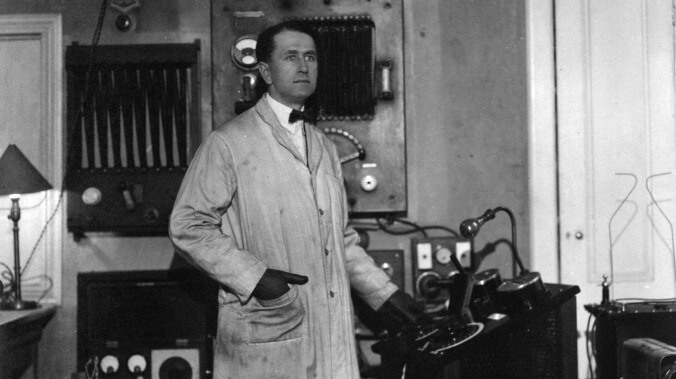This inventor’s death ray was totally real, but no one was allowed to see it

This week’s entry: Harry Grindell Matthews
What it’s about: The inventor of a death ray! Or a liar. And let’s face it, one of those two is more likely than the other. In 1923, Matthews declared that he had invented a ray that could stop an engine, ignite gunpowder, and incapacitate enemy soldiers from as far as four miles away. The only trouble was, he refused to provide more than a very limited demonstration of the device.
Biggest controversy: Matthews was big on inventing, but not that big on providing proof. In 1911, he claimed to have invented a radiotelephone that could transmit messages to an airplane in flight up to two miles away. (The wireless telegraph, a much simpler means of communicating with aircraft, debuted that same year.) The British Admiralty was interested in the device, but Matthews demanded that no experts be present at the demonstration, and when someone dismantled and inspected the apparatus before the demonstration, he canceled the whole thing.
In 1921 he claimed to have invented the first movie with sound (the technology had already existed since 1900). Three years later, the War Office expressed an interest in his death ray, and he didn’t respond, instead demonstrating the device to a reporter. He refused to say how the ray worked, did a brief demonstration for the Air Ministry, and refused to show off the device again.
Strangest fact: Matthews refused to demonstrate the power of his death ray in three different countries. When the British government insisted on a more thorough demonstration before they could offer Matthews any payment, he insisted he didn’t need their money, as he already had backers lined up in France. He flew to Paris (with his English investors literally chasing him to the airport to stop him), and the gambit worked in the short-term, with British shipping magnate Sir Samuel Instone offering Matthews a huge salary if he’d keep the ray in Britain and demonstrate how it worked. Matthews refused, only showing a film of a device that didn’t resemble the one from his earlier demo.
A month later, Matthews was in America, peddling, but not demonstrating, his wares. He turned down a $25,000 offer to demonstrate the death ray at Madison Square Garden. He returned to Britain declaring victory, claiming he had sold the device to an American buyer, but he refused to name the party or provide any evidence.
Thing we were happiest to learn: Matthews’ wife’s story is as interesting as his. In 1938, after continuing his questionable career as an inventor, the 57- or 58-year-old married Ganna Walksa. Walksa was a Polish opera singer who had already outlived one husband, divorced two more, and had a marriage annulled. Her first four husbands had a combined net worth of $125 million, and that’s in 1938 dollars. Her fourth husband, Harold McCormick, spent a fair amount of his fortune promoting Walksa’s career as an opera singer, leading Roger Ebert to theorize that the character of Susan Alexander in Citizen Kane was based on Walska. Wikipedia says her reputation was mediocre, her voice was “pleasing only to McCormick,” and that she was once pelted with rotten vegetables when she couldn’t stay on key.
Thing we were unhappiest to learn: When Matthews actually did demonstrate an invention, it failed. By 1930, Matthews was back in England, and debuted a Sky Projector, which projected images onto clouds. He lit up clouds with “Happy Christmas” and a working clock face. The invention didn’t make him any money, and by the following year Matthews was bankrupt, as “he had used most of his investors’ money for living in expensive hotels.”
Yet somehow, four years later, he built a fortified laboratory and an airfield in Wales. In 1935, he claimed to be working on “aerial mines,” and, in 1937, a system for detecting submarines, but by that point, the British government had long since dismissed him as a crank. He died of a heart attack in 1941.
Best link to elsewhere on Wikipedia: Late in life, Matthews was a member of the British Interplanetary Society, a group that’s been advocating space exploration since 1933. While the group was unable to test rockets, as the Explosives Act of 1875 made such private tests illegal, it designed a concept moon rocket and lander in the late ’30s not fundamentally different than Apollo 11. The group published Project Daedalus in 1978, a feasability study on sending an unmanned mission to Barnard’s Star with a nuclear-powered rocket that was feasible with current technology. In 2007, it published designs for a manned station on Mars’ North Pole.
Further down the Wormhole: Matthews did successfully sell one invention to the government. When WWI broke out, the British Admiralty was looking for a way to shoot down zeppelins, and paid Matthews £25,000 for an apparently-functioning remote control vehicle. Zeppelins, the rigid airships behind the Kaiser’s air superiority and everyone’s steampunk fantasies, dropped bombs on the Allies all through the Great War. Wikipedia makes the distinction that a bomb is an explosive used as a weapon, as opposed to one used in mining or construction. But when things go wrong, as they did in the Texas City Disaster, an accidental explosion can be as devastating as any weapon of war. We’ll look at the worst industrial accident in American history next week.